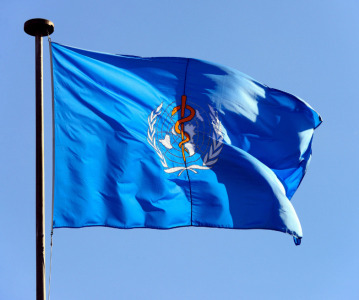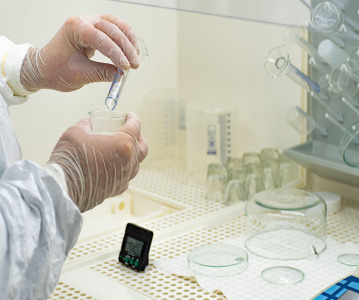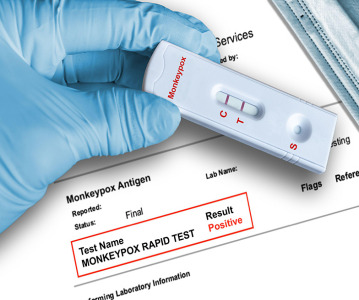NIH-Funded Scientists Create Potential Long-Acting HIV Therapeutic

Scientists have created a new molecule that shows promise for controlling HIV without daily antiretroviral drugs. The molecule foils a wider range of HIV strains in the laboratory than any known broadly neutralizing HIV antibody and is more powerful than some of the most potent of these antibodies. In addition, the molecule safely protected monkeys from infection with an HIV-like virus during a 40-week study period. Together, the data suggest that the molecule could, with further research, be used to subdue HIV in humans. The authors note that the molecule potentially could be used as both a preventative drug and as a treatment. The new findings appear in the 18 February issue of the journal Nature.
“This innovative research holds promise for moving us toward two important goals: achieving long-term protection from HIV infection, and putting HIV into sustained remission in chronically infected people,” said Anthony S. Fauci, director of the National Institute of Allergy and Infectious Diseases (NIAID), part of the National Institutes of Health.
The research was led by Michael Farzan, a professor in the department of infectious diseases at The Scripps Research Institute in Jupiter, Florida. The work was funded primarily by NIAID.
The new molecule is called eCD4-Ig and works by tightly binding to two unchanging sites on the surface of HIV that the virus uses to attach to receptors on cells called CD4 and CCR5. Typically, when HIV attaches to these receptors, it unlocks a door to the cell and gets inside. However, when eCD4-Ig binds to HIV, it effectively takes away the virus’s key, locking it out of the cell and preventing it from multiplying.
“Our molecule appears to be the most potent and broadest inhibitor of HIV entry so far described in a preclinical study,” said Dr Farzan. “If one could inject either eCD4-Ig or our gene therapy tool into people with HIV infection, it might control HIV for extended periods in the absence of antiretroviral drugs. Further research will help illuminate the promise of these approaches.”
To build on their findings, the scientists are studying both the therapeutic potential of eCD4-Ig in monkeys infected with HIV-like viruses and the ability of eCD4-Ig to prevent infection against a wider range of HIV and HIV-like strains.
NIAID has funded the newly published and ongoing research through an initiative called Beyond HAART: Innovative Therapies to Control HIV-1, which supports the development of strategies for suppressing HIV in the absence of antiretroviral drugs.
Related News
-
News CPHI Frankfurt 2022: Innovator Interview – DSM Biomedical
At CPHI Frankfurt we spoke to Anne-Cecile Bayne, Global Science & Innovation Lead Pharma and Medical Nutrition, and Marc Hendriks, Vice President Strategy & Business Development, on their expertise in nitrosamines and business strategy at DSM Biomedica... -
News New WHO health emergency guidelines expect full transparency from Big Pharma
The WHO are proposing a new set of pandemic guidelines to set out how future global health crises should be handled. -
News Magic mushrooms could be used to treat mental health conditions
A compound found in magic mushrooms, psilocybin, could be used to treat mental health conditions and help patients suffering with severe depression, as shown by the results of the largest study of its kind to date. -
News UK-based partnership to launch DETERMINE study into rare cancer research
UK-based CRO Quanticate is set to partner with Cancer Research UK for the launch of the DETERMINE study focused on testing a range of existing and approved drugs and therapies on rare cancers. -
News FDA approves Thermo Fisher blood tests for wheat and sesame allergies
Both tests have been approved by the US regulator for in vitro diagnostic use -
News QIAGEN launches world’s first syndromic test for monkeypox
The test can distinguish between monkeypox and other diseases that cause similar symptoms. -
News Monkeypox Update: Vaccine shortage, sewage surveillance and global testing
As concern over the monkeypox outbreak continues to rise, we take a look at major developments from the first week of August. -
News CPHI Podcast Series: The importance of novel excipients for innovative drug development
The latest episode in the CPHI Podcast Series dives into the world of novel excipients and explores their importance for innovative drug development.
Position your company at the heart of the global Pharma industry with a CPHI Online membership
-
Your products and solutions visible to thousands of visitors within the largest Pharma marketplace
-
Generate high-quality, engaged leads for your business, all year round
-
Promote your business as the industry’s thought-leader by hosting your reports, brochures and videos within your profile
-
Your company’s profile boosted at all participating CPHI events
-
An easy-to-use platform with a detailed dashboard showing your leads and performance


.png)




